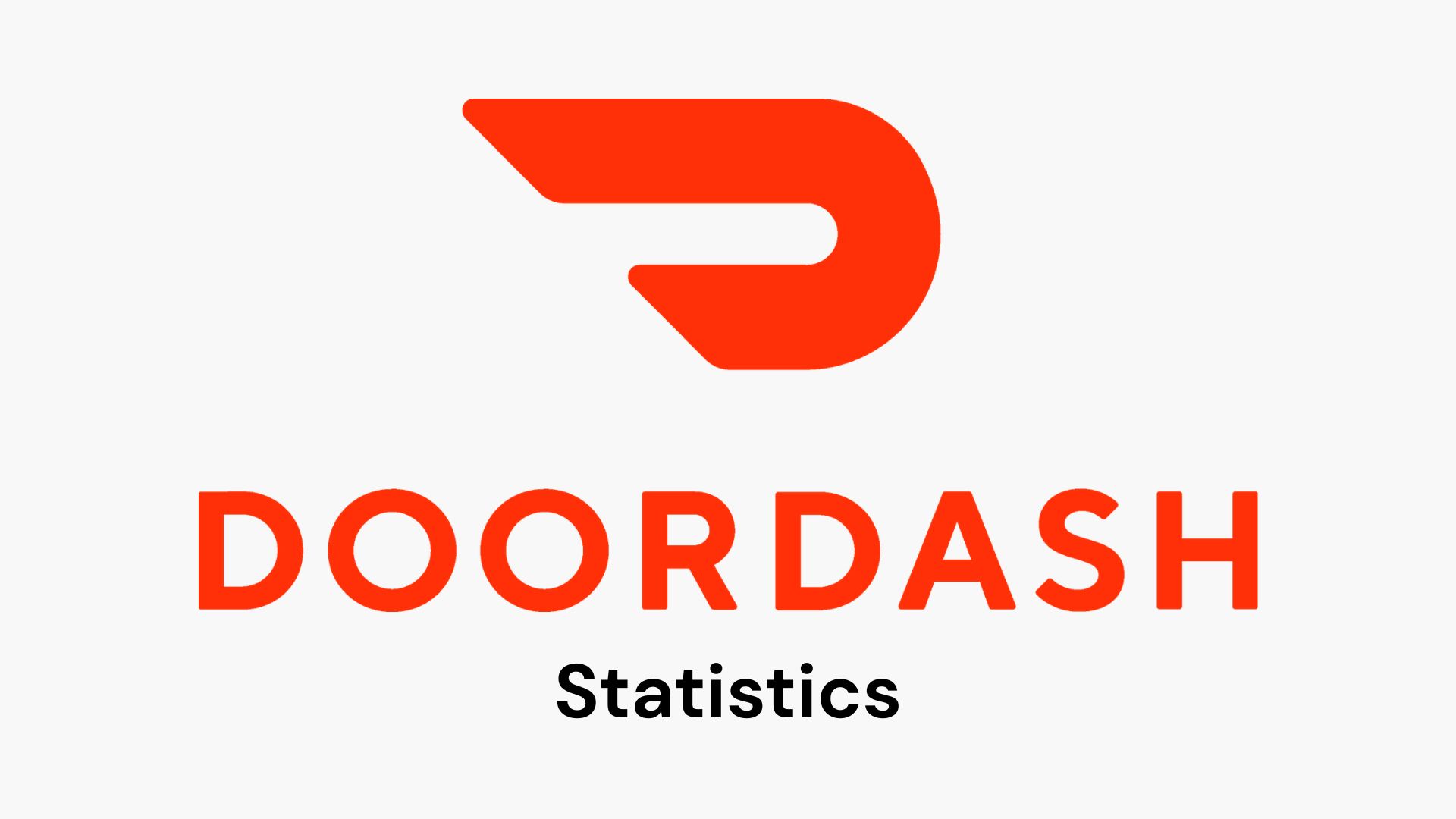Web Hosting Statistics By Revenue And Market Share
Updated · Nov 27, 2024

Table of Contents
- Introduction
- Editor’s Choice
- Web Hosting Industry Revenue
- Comparative Estimates – IT services
- Average Spend Per Revenue
- Market Share of Web Hosting Key Players
- Top Web Provider Revenue
- Online Sales Growth Revenue Web Hosting Services in Germany
- Global Web Hosting Market Share By Application
- Popular Domains on Websites
- Most Popular Web Servers
- Popular Server-Side Languages
- Leading Cloud Marking Share Providers
- Popular Web Hosting Providers
- Web Hosting Overview
- Conclusion
Introduction
Web Hosting Statistics: Web hosting is a hosting service that provides hosting services for clients. For the most part, it provides the different features that enable them to create and maintain a website server and thus provide a service for different companies in their domains.
As we go through the Web Hosting Statistics, we can learn about the relevant features that are pivotal for this business industry’s growth on a holistic level. Accordingly, one will be able to discern the history and factors that can ensure the success of business models.
Editor’s Choice
- Web hosting industry revenue reached $130.10 billion in 2023
- AWS dominates cloud services with 33.6% market share
- PHP leads server-side languages with 76.4% market share
- Public websites account for 48.2% of web hosting applications
- .com domains control 45.2% of all website domains
- Nginx leads web servers with 34.3% market share
- Average spend per employee in web hosting reached $36.90 in 2023
- Amazon Web Services generated $514 billion in revenue in 2022
- North America holds 51.40% of the global web hosting market
- WordPress powers 63.4% of CMS-based websites
- The cloud hosting market shows a 40% annual growth rate
- German web hosting revenue reached $5,242 million in 2023
- Mobile applications represent 26.9% of hosting market share
- Azure holds 24% of the cloud provider market share
- GoDaddy generated $4.09 billion in revenue in 2022
Web Hosting Industry Revenue
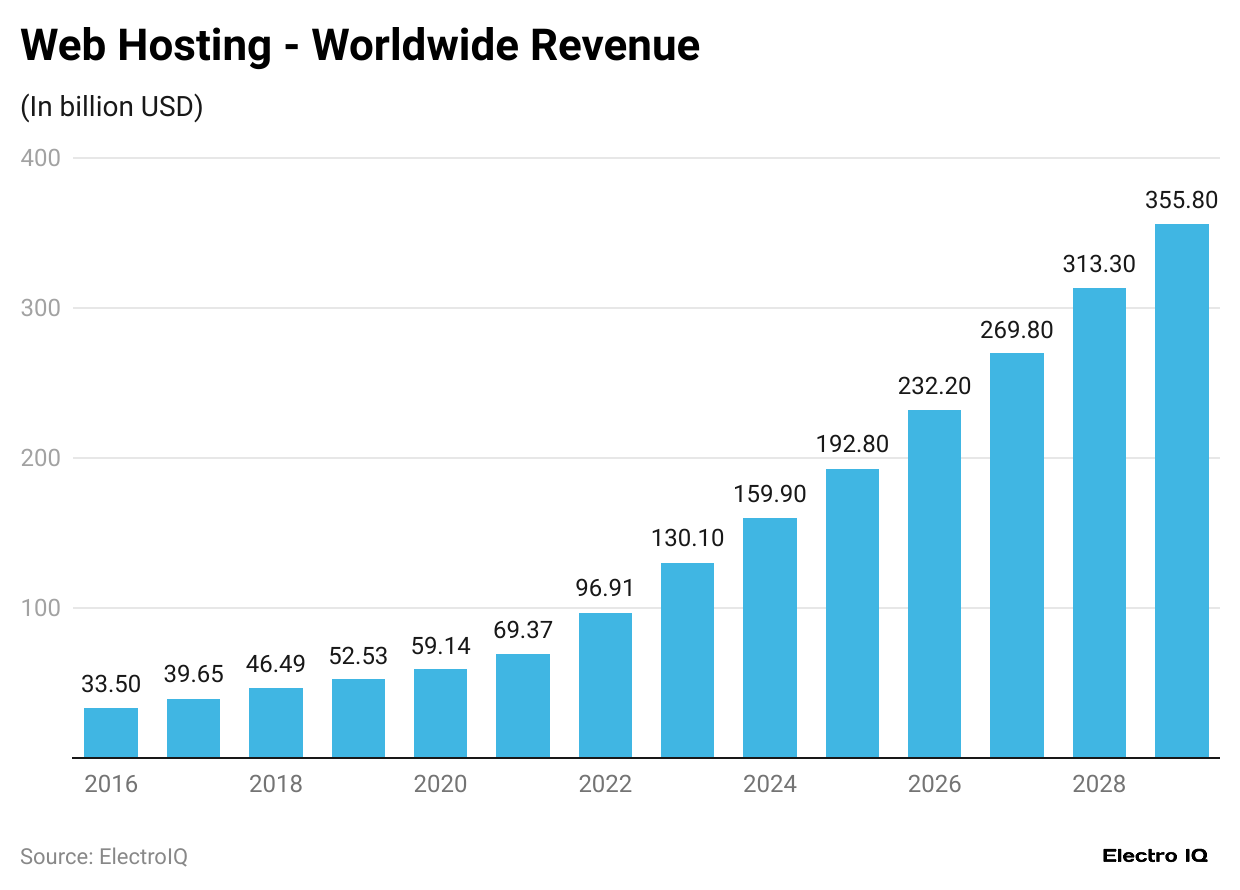
(Reference: statista.com)
- Web Hosting Statistics show that the industry’s revenue has increased over time.
- In 2023, the revenue was $130.10 billion, a significant increase from 2016 to $33.50 billion.
- It is predicted that by 2029, the revenue from web hosting will be $355.80 billion.
Comparative Estimates – IT services
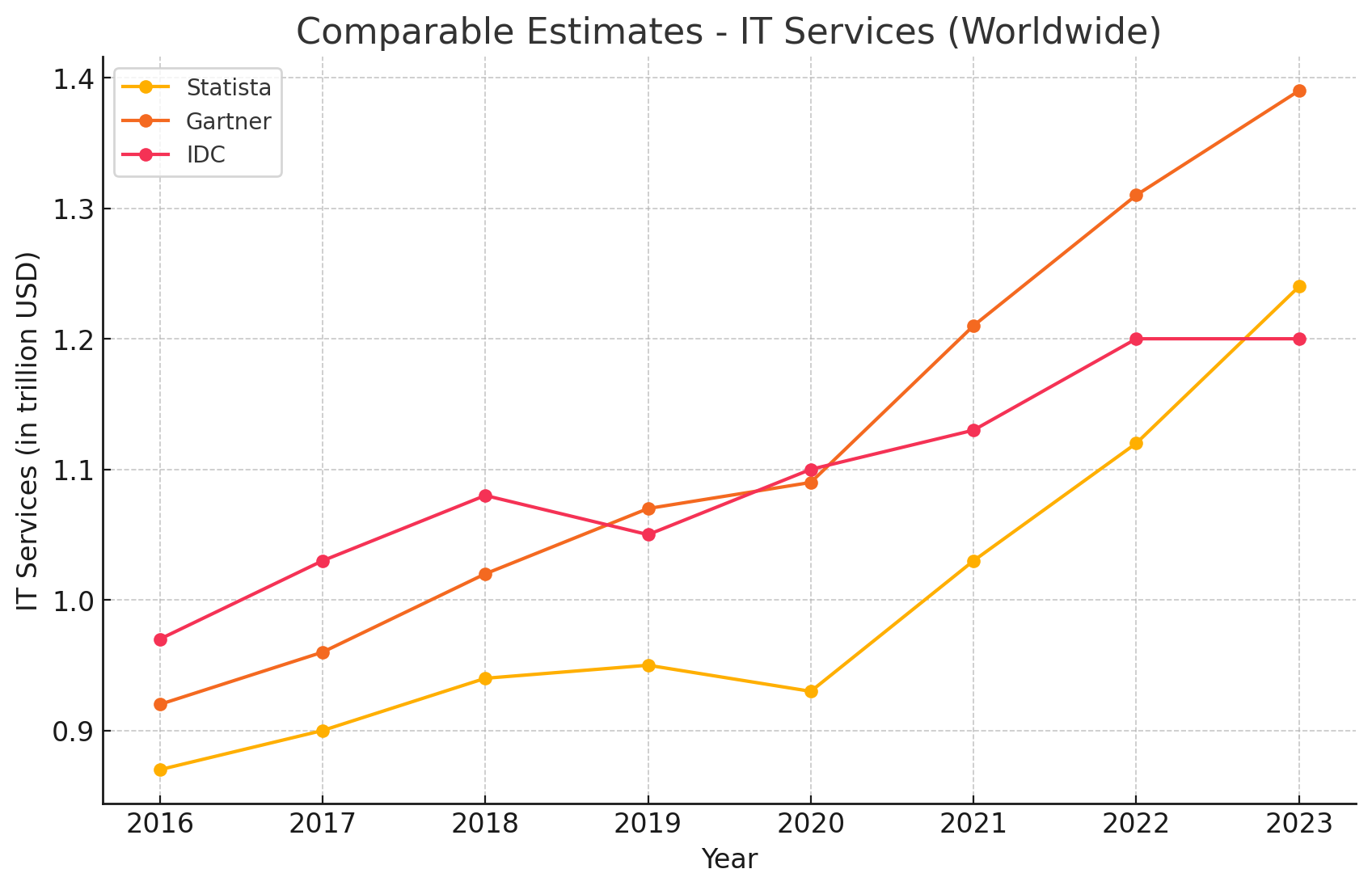
(Source: statista.com)
- Web Hosting Statistics show that IT services have been growing over time by different estimates.
- As of 2023, Statista predicted $1.24 trillion, while Gartner predicted $1.39 trillion in revenue. IDC showed revenue of $1.20 trillion.
Average Spend Per Revenue
(Reference: statista.com)
- Web Hosting Statistics average spend per employee was $36.90 in 2023 and is predicted to be $95.71 by the end of 2029.
- It shows the average spend per employee has been increasing over time.

(Source: statista.com)
- Web Hosting Statistics show that Amazon web services, Gidaddy, Endurance International Group, Ionos, and Google Cloud are popular web hosting services.
- Amazon web services have the highest market share at 33.6%, followed by Google Cloud at 9.4%, IONOS at 5.0%, Godaddy at 4.2% and Endurance at 1.3%.
Top Web Provider Revenue
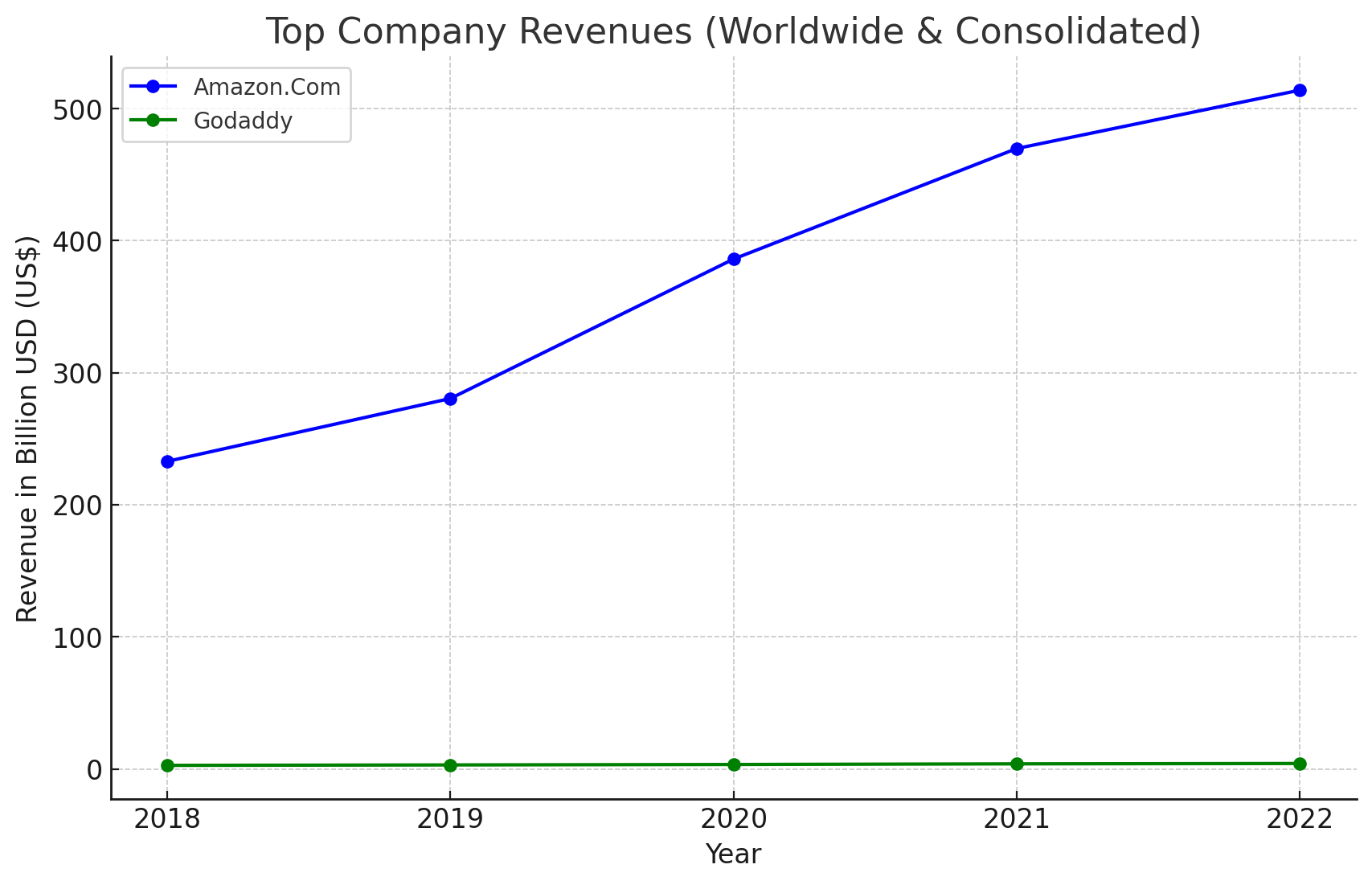
(Source: statista.com)
- Web Hosting Statistics show that Amazon and GoDaddy are popular web providers.
- In 2022, Amazon had the highest revenue with $514 billion, and Godaddy with $4.09 billion.
Online Sales Growth Revenue Web Hosting Services in Germany
(Reference: statista.com)
- Web Hosting Statistics show that the revenue of web hosting portals has been increasing over time.
- In 2012, the industry revenue was as follows: data processing with $1,570.96 million and web portals with $852.75 million. It increased in 2023 by $5,242 million, with web portal data processing at $3,557 million.
- Revenue is expected to come from web portals, with $5,683 million, and data, with $3,757,12 million, by 2025.

(Source: fortunebusinessinsights.com)
- Web Hosting Statistics The web hosting market share can be categorized into the following categories: Public website, online application, intranet site, and online application.
- Public websites have the highest market share, with 48.2%, followed by mobile applications, with 26.9%; intranet sites, with 15%; and online applications, with 10%.
Popular Domains on Websites
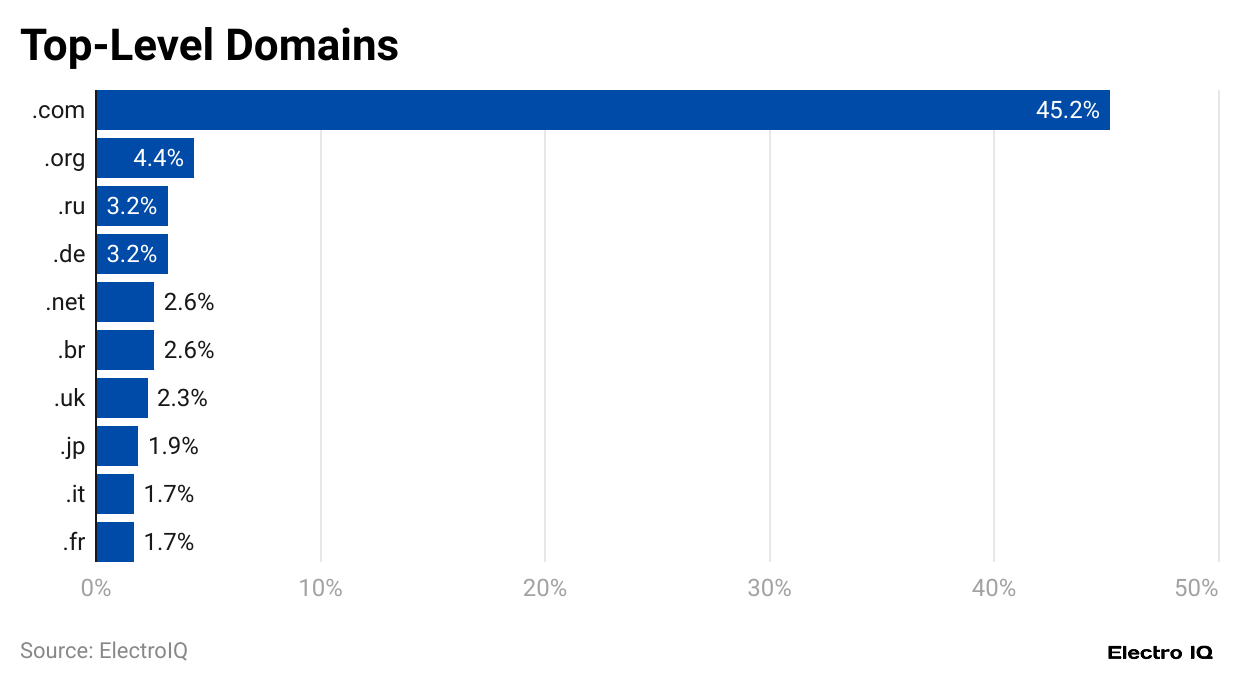
(Reference: bloggingwizard.com)
- Web Hosting Statistics show that .com is the most popular website domain.
- .com has the most popular domain with a 45.2% market share, followed by .org with 4.4%, .ru with 3.2%, and .net with 2.6%.
Most Popular Web Servers
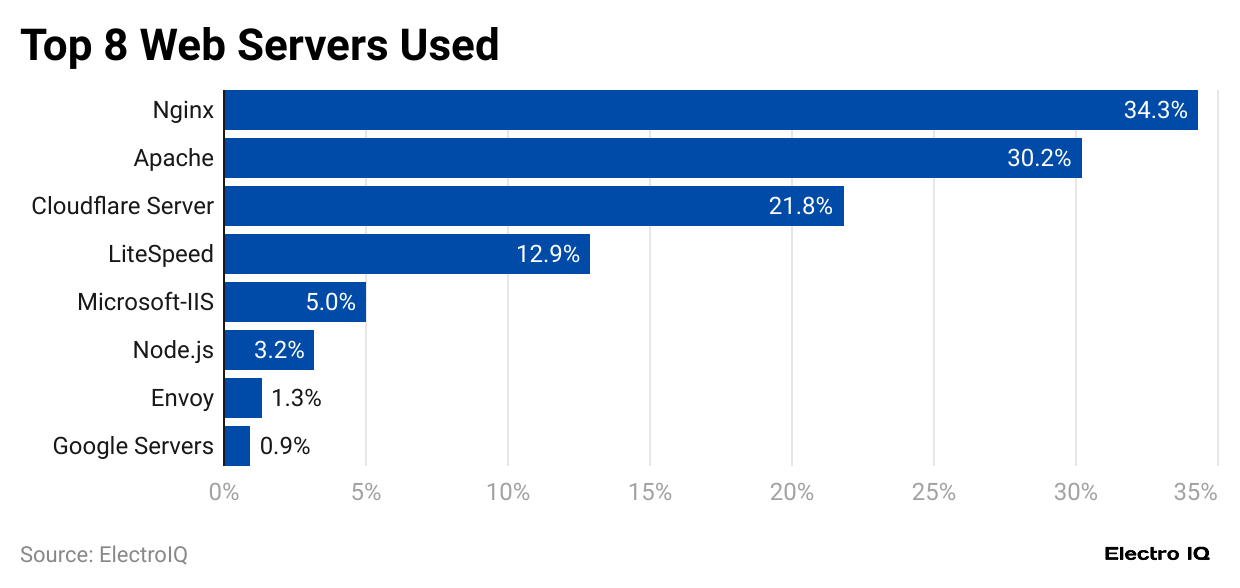
(Reference: bloggingwizard.com)
- Web Hosting Statistics show that LiteSpeed, Envoy, Apache, Google Servers, Cloudflare Server, Microsoft-IIS, Node.js, and Nginx are the most popular web servers worldwide.
- Nginx has the highest market share at 34.3%, followed by Apache at 30.2%, Cloudflare server at 21.8%, and Litespeed at 12.9%.
Popular Server-Side Languages
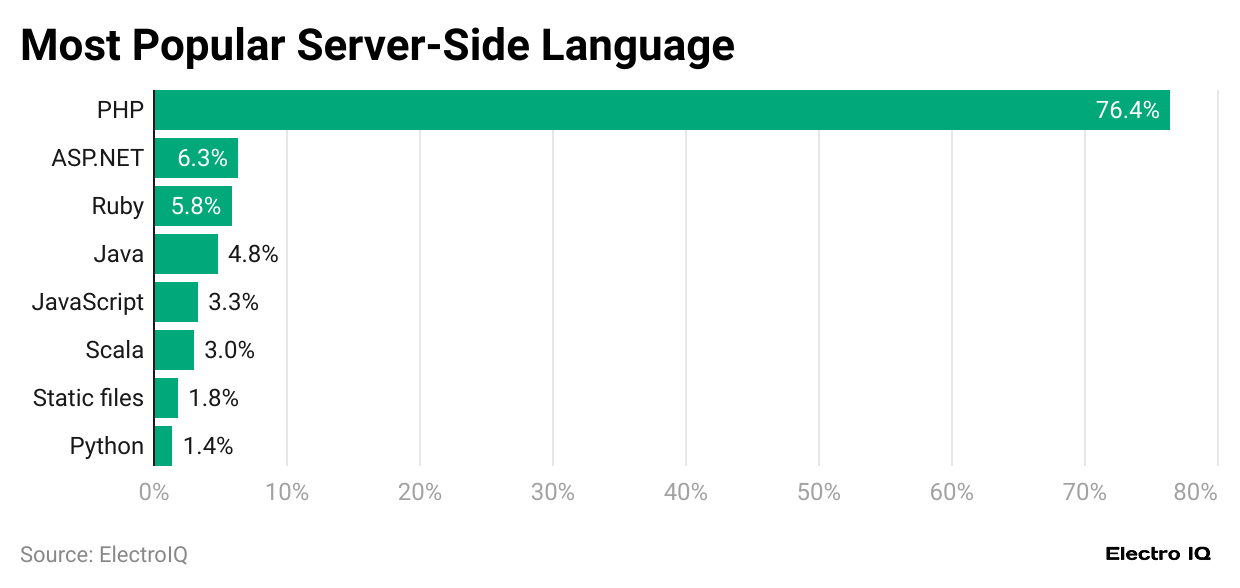
(Reference: bloggingwizard.com)
- Web Hosting Statistics show that Scala, Java, Ruby, Static files, ASP.NET, Python, JavaScript, and PHP are the most popular server-side languages.
- PHP has the highest market share, with 76.4%, followed by ASP.net with 6.3%, Ruby with 5.8%, and Java with 4.8%.
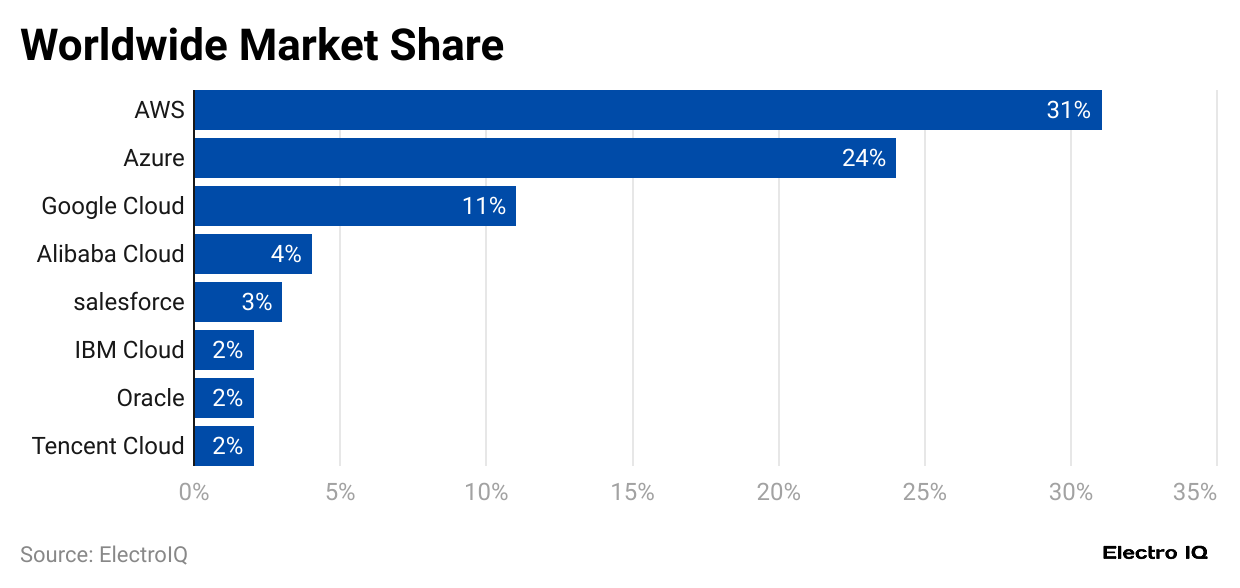
(Reference: bloggingwizard.com)
- Web Hosting Statistics show that IBM Cloud, Oracle, Tencent Cloud, Azure, Google Cloud, AWS, Salesforce, and Alibaba Cloud are popular cloud providers.
- AWS has the highest market share among cloud providers with 31%, followed by Azure with 24%, Google Cloud with 11%, and Alibaba Cloud with 4%.
Popular Web Hosting Providers
- HostPapa
- NearlyFreeSpeech
- CloudLinux OS
- Claranet
- Media Temple
- Alibaba Cloud
- Hostucan
- Code42
- Homestead Technologies
- OVHcloud
- Heart Internet
- Angelfire
- DDoS-Guard
- Fasthosts
- Aruba S.p.A.
- Mozy
- DreamHost
- Amazon Web Services
- DigitalOcean
- Hostinger
- Green hosting
- Lifeyo
- Namecheap
- com
- Logicworks
- Ispmanager
- Endurance International Group
- Rackspace Technology
- HostGator
- MediaGoblin
- GoDaddy
- GlowHost
- Enom
- Jimdo
- Easily Ltd
- com
- HostDime
- ZergNet
- EdgeUno
- IBM Cloud
- Infomaniak
- Gandi
- ISPConfig
- Backblaze
- Amazon ElastiCache
- Epik
- Bytemark
- WebMaker CMS
- IPage
- Hostway
- Colocation centre
- Ionos
- Web central
- IDrive Inc.
- Web Hosting Magazine
- Fantastico
- OpenShift
- BlueHost
- Asiatech Data Transmission
- NearlyFreeSpeech
Source: https://en.wikipedia.org/wiki/Category:Web_hosting
Web Hosting Overview
The web hosting market has been expanding rapidly, with significant growth in 2023 and projected for 2024. This growth is fueled by the increasing demand for digital infrastructure, the rise of e-commerce, and the widespread need for businesses to maintain an online presence. In 2023, the web hosting market was valued at several billion US dollars, and experts forecast consistent growth through 2024 and beyond, reaching new highs by 2032. Key factors driving this expansion include adopting cloud-based solutions, emerging eco-friendly hosting options, and advancing cybersecurity, all reshaping the industry's landscape.
#1. Web Hosting Market Segments and Growth Areas
- The web hosting industry includes various service types designed to meet different user needs. The primary categories are shared hosting, dedicated hosting, Virtual Private Server (VPS), and cloud hosting. Shared hosting remains the most economical option, making it popular among small businesses and personal users. Plans often start at a few US dollars per month. In this model, multiple users share a single server, which helps keep costs low and limits performance and control.
- VPS hosting provides an intermediate solution for businesses requiring greater resources and control, offering dedicated resources on a shared physical server. In 2023, VPS hosting continued to gain traction, especially among small and medium-sized enterprises (SMEs) seeking a balance between cost and performance. On the other hand, dedicated hosting is typically chosen by larger enterprises or websites with high traffic, as it provides exclusive access to an entire server. However, dedicated hosting is more costly, with monthly prices reaching hundreds of US dollars.
- The cloud hosting segment, led by Amazon Web Services (AWS), Google Cloud, and Microsoft Azure, is one of the fastest-growing areas within web hosting. Cloud hosting allows for flexible scaling of resources, making it ideal for businesses with fluctuating web traffic. AWS dominates this sector, holding around 64% of the market share, followed by Google Cloud with 8.09%, serving clients like Snapchat and Spotify. The cloud hosting market is projected to continue expanding, with annual growth rates reaching 40% in recent years as more businesses adopt cloud-based infrastructure.
#2. The Rise of Eco-Friendly Hosting
Another trend shaping the web hosting industry is the push towards sustainability. As environmental concerns become more prominent, many web hosting companies focus on reducing their carbon footprints. Green hosting providers like GreenGeeks and A2 Hosting have committed to using renewable energy and offsetting carbon emissions. For example, GreenGeeks invests in wind energy credits at 300% of its energy consumption, setting a benchmark for eco-conscious web hosting solutions. This approach appeals to environmentally conscious consumers who prioritize sustainability when selecting a hosting provider. As a result, eco-friendly hosting is becoming a competitive differentiator in the market.
#3. Geographic Market Distribution
The demand for web hosting services is global, but North America holds a significant market share, accounting for approximately 51.40% of the industry in 2023. This is largely due to the region's high concentration of technology companies, startups, and internet-driven businesses. The United States hosts over 5,000 web hosting providers, with major players like GoDaddy, Bluehost, and HostGator catering to various customer needs. Europe, particularly countries like Germany and the UK, is another prominent market, hosting several competitive providers. In Asia, growth is driven by increasing internet penetration and the rise of digital businesses in emerging markets such as India and China.
#4. Web Hosting Cost Structures
Web hosting costs vary significantly depending on the type of hosting and the client's specific needs. Shared hosting remains the most budget-friendly option, making it accessible to individuals and small businesses. However, as companies grow and their website traffic increases, they often transition to VPS or dedicated hosting to meet their performance requirements. VPS hosting generally costs more than shared hosting, while dedicated hosting is the most expensive, sometimes reaching hundreds of US dollars monthly.
Cloud hosting offers a unique pricing model that charges users based on usage. This scalability allows companies to manage costs effectively by adjusting their resources as needed, which is particularly beneficial for businesses experiencing fluctuating traffic. Additionally, many cloud providers offer free tiers or discounted pricing to attract new customers, making cloud hosting a flexible and cost-effective solution for businesses of all sizes.
#5. Security and Customer Support as Key Selling Points
With the rise of cyber threats, security has become a top priority in the web hosting industry. Many providers now offer enhanced security features, including DDoS protection, SSL certificates, and daily backups, to safeguard clients' data. These security measures are especially critical for e-commerce websites, which handle sensitive customer information. Web hosting companies also emphasize customer support, offering 24/7 assistance to help clients address technical issues quickly. High-quality customer support is essential for businesses without in-house IT teams, as it ensures website reliability and minimizes downtime.
#6. The Role of CMS Integration
Content management systems (CMS) like WordPress are increasingly integrated into web hosting packages. As of 2024, WordPress powers over 63.4% of websites using a CMS, making it a popular choice among users seeking an easy-to-manage web platform. Web hosting providers often offer one-click WordPress installations and specialized support for CMS users, further driving the demand for hosting services that cater to WordPress users. This trend will continue as more individuals and businesses adopt CMS content creation and management platforms.
#7. Future Outlook for the Web Hosting Market
The web hosting market is projected to experience consistent growth, reaching unprecedented levels by 2032. Key drivers of this growth include continued digitalization across industries, advancements in cloud technology, and the expansion of e-commerce. As more businesses transition to online operations, the demand for reliable and scalable web hosting solutions will increase. Additionally, innovations such as AI-driven optimization and enhanced data protection will likely shape the industry, offering new benefits for users and differentiating providers in a competitive landscape.
In conclusion, the web hosting market in 2023 and 2024 is characterized by robust growth, driven by rising demand for digital infrastructure and the shift towards cloud-based solutions. With various options ranging from shared to dedicated and cloud hosting, the industry caters to a wide range of users, from small businesses to large enterprises. As the market continues to evolve, web hosting providers will need to adapt to trends like sustainability, security, and CMS integration to meet the changing needs of their clients. Web Hosting Statistics indicate a promising future for the industry, with significant revenue growth projected for the coming years. The market's adaptability and innovation will likely ensure its continued expansion, solidifying web hosting as an essential digital economy component.
Conclusion
The web hosting industry demonstrates robust growth and evolution, marked by significant technological advancements and market expansion. Web Hosting Statistics show that the industry's future appears promising, with projected growth to $355.80 billion by 2029, driven by increasing digitalization and the growing demand for reliable hosting solutions.
The diversification of hosting options, from shared to cloud-based services, ensures that businesses of all sizes can find suitable solutions for their needs. As the industry moves forward, the focus on innovation, sustainability, and customer-centric solutions will likely continue to drive growth and evolution.
Sources
FAQ.
The industry is expected to reach $355.80 billion by 2029.
AWS leads with a 33.6% market share, followed by Google Cloud (9.4%) and IONOS (5.0%).
Public websites dominate with 48.2% of the market share.
PHP leads with a 76.4% market share.
.com domains lead with a 45.2% market share.
The average spend was $36.90 per employee in 2023.
North America leads with 51.40% market share.
Nginx leads with a 34.3% market share.
Amazon Web Services generated $514 billion in 2022.
63.4% of websites using a CMS are powered by WordPress.

Saisuman is a skilled content writer with a passion for mobile technology, law, and science. She creates featured articles for websites and newsletters and conducts thorough research for medical professionals and researchers. Fluent in five languages, Saisuman's love for reading and languages sparked her writing career. She holds a Master's degree in Business Administration with a focus on Human Resources and has experience working in a Human Resources firm. Saisuman has also worked with a French international company. In her spare time, she enjoys traveling and singing classical songs. Now at Smartphone Thoughts, Saisuman specializes in reviewing smartphones and analyzing app statistics, making complex information easy to understand for readers.







